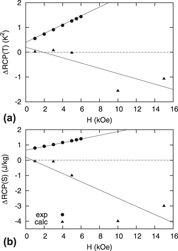Article contents
Magnetization and magnetocaloric effect in La0.7Pb0.3MnO3 ceramics and 0.85(La0.7Pb0.3MnO3)–0.15(PbTiO3) composite
Published online by Cambridge University Press: 17 December 2014
Abstract

The magnetization behavior under temperature and magnetic field variation was investigated for La0.7Pb0.3MnO3 ceramics and ferromagnetic–ferroelectric 0.85(La0.7Pb0.3MnO3)–0.15(PbTiO3) composite. The second-order ferromagnetic phase transition in manganite is shifted to the tricritical point in composite material. Comparison of the intensive caloric effect and the difference between relative cooling powers (RCP) in both materials proves a significant role of intrinsic pressure in elevating caloric efficiency in composite induced by elastic coupling between the grains of LPM and PT components. No temperature change in composite under an electric field of 2 kV/cm associated with electrocaloric effect or indirect magnetoelectric coupling was observed. The effect of magnetic field on some peculiar temperatures is considered. A contribution from pressure generated by magnetic field to baric coefficient dT/dp of ferromagnetic transformation temperature in composite was suggested. The results obtained were analyzed in the framework of the magnetic equation of state and compared with the experimentally measured heat capacity.
- Type
- Articles
- Information
- Copyright
- Copyright © Materials Research Society 2015
References
REFERENCES
- 9
- Cited by


